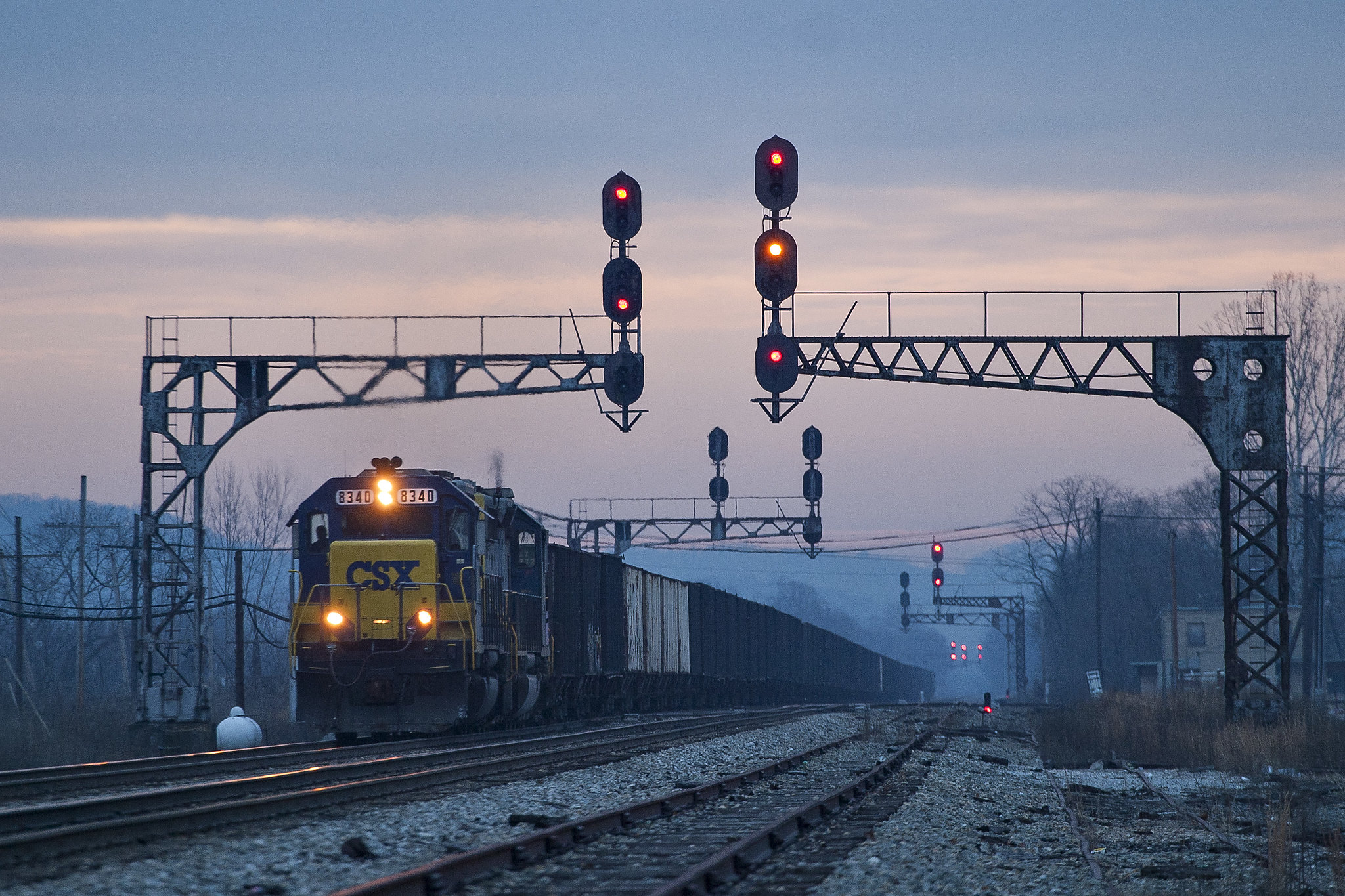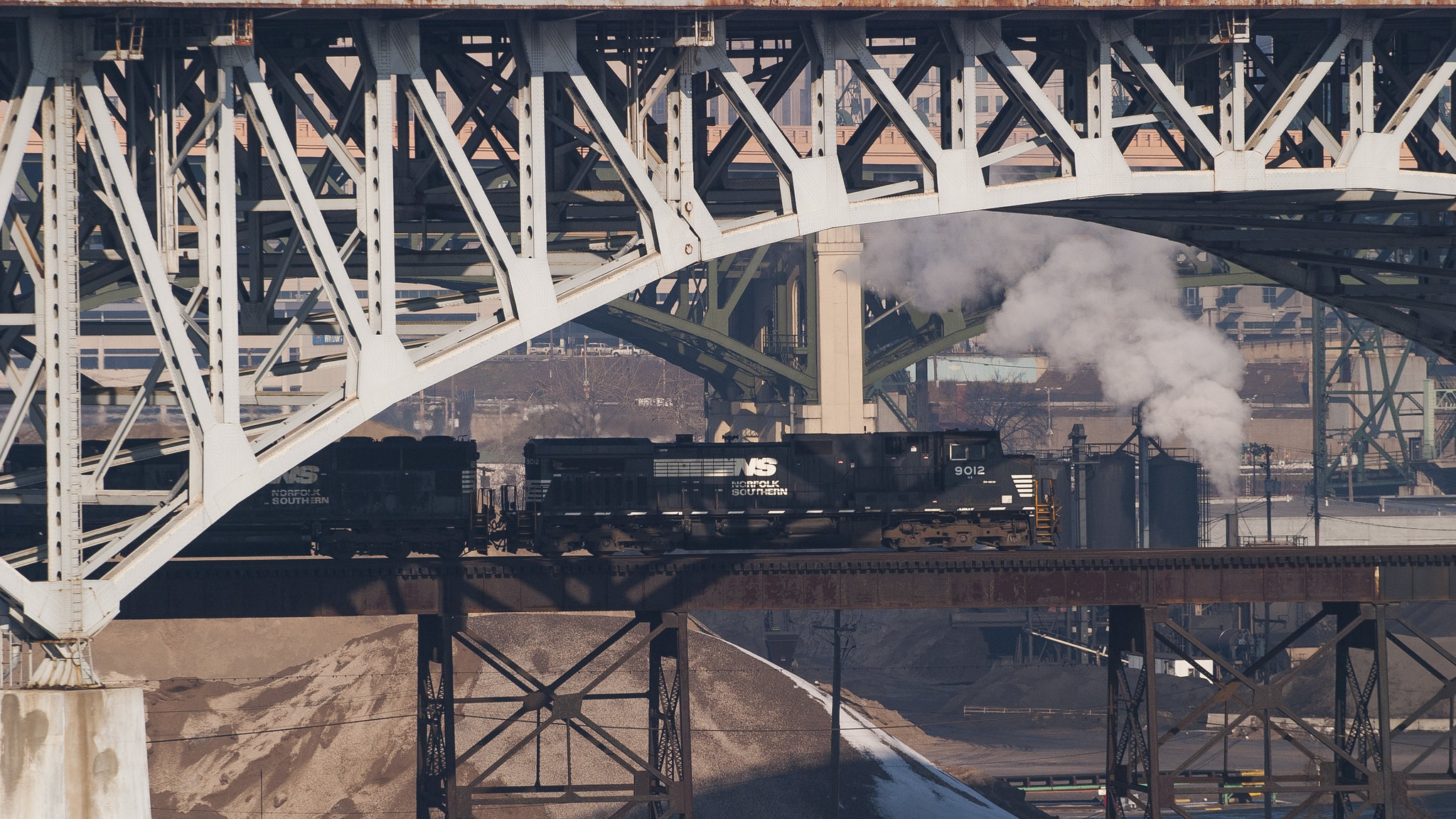I am the president and executive director of the nonprofit Center for Railroad Photography & Art and the editor of its journal, Railroad Heritage. I am also a freelance writer and photographer concerned primarily with railroads and other transportation networks, and how they interact with the lands they traverse. Read on to learn more about these interests, or jump straight to my CV.
The railroad bisects St. Albans, West Virginia, the town where I grew up. It does more than just bisect it though—when I was a kid, the railroad was the single most prominent feature of St. Albans. It was a boulevard of steel, six tracks wide all the way through town, arrow-straight to the horizon in both directions and elevated a full story above street level. You looked up to see the tracks, way up to see the ominous black coal hoppers towering above you, and up toward the heavens themselves to see the great black arms of the cantilevered signal bridges with all their lights glowing red, yellow, and green through day and night. The railroad was a presence here, inescapable, indelible.
The trains were enormous—two, three, sometimes four big yellow diesel locomotives leading a hundred or more of the black hopper cars and, in my earliest memories, a yellow caboose bringing up the rear. I learned to count on those relentless coal cars—and I learned very quickly what drove my home state’s economy
No matter where you were in St. Albans, you could always hear the trains. The town is long and narrow, hemmed in by mountains and the Kanawha River, never straying more than a few blocks from the railroad corridor in either direction. To most, I suppose the railroad was simply there, providing background noise and frequent, expected delays while running errands. To me, though, it was so much more.

I vividly remember the Christmas when I was two, greeting my Uncle Steve at the door to my grandparents’ house, and tearing back the red and white paper on the big box he carried inside: the Chattanooga Choo Choo, in HO scale. I remember a little about turning three a few months later, although I can’t recall the party itself. What I do remember is Grandpa taking me for a walk, probably so Mom and Grandma could get things ready, down to the tracks to look at the locomotives and cabooses parked by the railroad’s small office.
My parents divorced not long after I was born, and I grew up as an only child, and only grandchild on my mother’s side. Family life was warm and nurturing, but I had separation anxiety and didn’t do well around other kids, so elementary school posed some challenges. Trains were my escape. Inspired by the real ones, my toys and models gave me my own worlds where I could be in charge. And like those steel rails running off to the horizon on either end of town, they could take me anywhere.
I never gave much thought to working for a railroad, though. My mom and her two brothers were first-generation college graduates, and there was no question that I would go to college, too. Once I got through most of my social anxieties, around junior high, I did well in school. I had started drawing—trains, of course—from the time I could hold a pencil. I liked art and loved mechanical drawing classes, and in seventh grade I decided I would become an architect.
Then college visits came, starting the summer before my senior year. Mom had remarried when I was ten, and in eighth grade we had followed my stepfather’s career across the Ohio River to the rolling hills, small farming towns, and sleepy railroads of southeastern Ohio. The first math teacher I had there had wondered aloud whether a kid from West Virginia could cut it in his Algebra I class. Taking that challenge personally, I made straight A’s all the way through high school. Lacking much exposure to broader academic or art communities, I thought I was pretty smart.
Those first college visits took me to architecture studios showcasing projects that looked completely abstract to me. I could not relate to them, and decided that I could not relate to the profession of architecture. With my life’s plan derailed at age seventeen, I panicked. “What’s like architecture, but more practical?” I asked myself. The answer seemed obvious. Engineering.
Case Western Reserve University in Cleveland offered no architecture degrees but one of the best engineering programs in the Midwest and generous financial aid. Plus it just “felt” right. Some of the urban campuses I visited came across as austere and foreboding. CWRU was cozy and inviting, and the people I met with made me feel like a person, and not just a number—and that was hugely reassuring for a small-town kid heading into the city. And it probably didn’t hurt that three sets of railroad tracks cut right through South Campus.

In a lab class during my sophomore year, I saw a BNSF tag on another student’s backpack. I asked him if it stood for Burlington Northern Santa Fe, and he grinned. Paul and I became fast friends, and he introduced me to photography. I stopped drawing about a year earlier, frustrated with a plateau in my abilities. I could draw manmade objects quite well, but natural subjects eluded me, and I found myself wanting to include more and more of the landscape into my images. Photography let me do that, while filling the creative void left after I had stopped drawing.
CWRU was a great choice as a school, but engineering was a terrible choice as a major. The math classes went so fast that I felt like I was playing catch up the entire time I was there. After years of helping high school classmates in math and science, it was a difficult adjustment to be the one asking for help. I found great friends who got me through, but by the time I graduated, I knew I didn’t want to spend a career in engineering. Luckily, I didn’t have to.
I have always enjoyed writing, but despite editing my high school newspaper, it took a serendipitous job offer from an engineering magazine for me to start considering myself a writer. Math and science had defined me through high school, but I peaked with Calculus I. Writing was barely an afterthought in college, where I wrote most of my papers on the night before they were due. Yet I always did well in writing-based classes, while struggling where I had to solve equations. The magazine’s publisher visited one of my classes in my last semester, and I had the job lined up before graduation.
Working as the assistant editor of an engineering magazine brought further clarity to my life’s ambitions. I quickly realized I was identifying far more with writing and editing than with the engineering subject matter. I began to read more; Steinbeck was my gateway author and others soon followed, both on my own and through literature classes at the community college.
I had also met someone. Maureen was my roommate’s girlfriend’s roommate and soon became my partner, best friend, and muse. She graduated a semester after me and after a couple of years of administrative work in Cleveland, she was ready for a change. I was, too. We spent the next two years in Asia, mostly teaching English in Japan but also traveling to Vietnam together, and I spent three months in China. With more time to devote to them, my creative pursuits began to blossom.
After returning to the U.S., we both found graduate programs, but none of them were located very close to each other. Not wanting to start our new lives back in the U.S. by living hundreds of miles apart, we chose a master’s degree program for Maureen at Oregon State University in Corvallis. I found enough freelance writing, photography, and web design work to support myself, and one of my first clients was a nonprofit called the Center for Railroad Photography & Art. A year after Maureen received her master’s degree, I received an offer to become the Center’s full-time executive director. We moved from Oregon to Wisconsin in August 2011 and have been in Madison ever since.